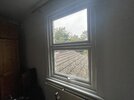Hello,
Struggling here. I would really appreciate some advice!
We moved into a Victorian conversion flat late last year. (We are the middle flat of three) Two bedrooms. One of the bedrooms is an outrigger extension. It has three external walls & a small attic space above. Solid external walls. It is also at the back of the building & only gets a tiny bit of sun late in the day.
We quickly noticed that it was colder than the rest of the flat. We’d love to do something about it sooner rather that later, but don’t want to lose to much space (it’s 3.4 x 3.4M) or spend a whole lot (We’re not positive how long we’ll be here.)
I also understand that with solid Victorian brick you can’t just stick plasterboard on to it? I understand that it needs to breathe. (Are there insulated plasterboard panels that can just be attached to the wall with adhesive?) I’ve been reccommended some 12.5mm Vapor Panels, by a decorator but not sure they’re right for Victorian walls.
Also, considering the Wallrock Thermal Lining Wallpaper KV600 as a cheaper alternative, plus some thick carpet & curtains & some more insulation in the attic space.
Happy to spend a little money, but getting many conflicting opinions & really don’t want to cause more trouble with damp/mould.
Thank you!!!
Struggling here. I would really appreciate some advice!
We moved into a Victorian conversion flat late last year. (We are the middle flat of three) Two bedrooms. One of the bedrooms is an outrigger extension. It has three external walls & a small attic space above. Solid external walls. It is also at the back of the building & only gets a tiny bit of sun late in the day.
We quickly noticed that it was colder than the rest of the flat. We’d love to do something about it sooner rather that later, but don’t want to lose to much space (it’s 3.4 x 3.4M) or spend a whole lot (We’re not positive how long we’ll be here.)
I also understand that with solid Victorian brick you can’t just stick plasterboard on to it? I understand that it needs to breathe. (Are there insulated plasterboard panels that can just be attached to the wall with adhesive?) I’ve been reccommended some 12.5mm Vapor Panels, by a decorator but not sure they’re right for Victorian walls.
Also, considering the Wallrock Thermal Lining Wallpaper KV600 as a cheaper alternative, plus some thick carpet & curtains & some more insulation in the attic space.
Happy to spend a little money, but getting many conflicting opinions & really don’t want to cause more trouble with damp/mould.
Thank you!!!


